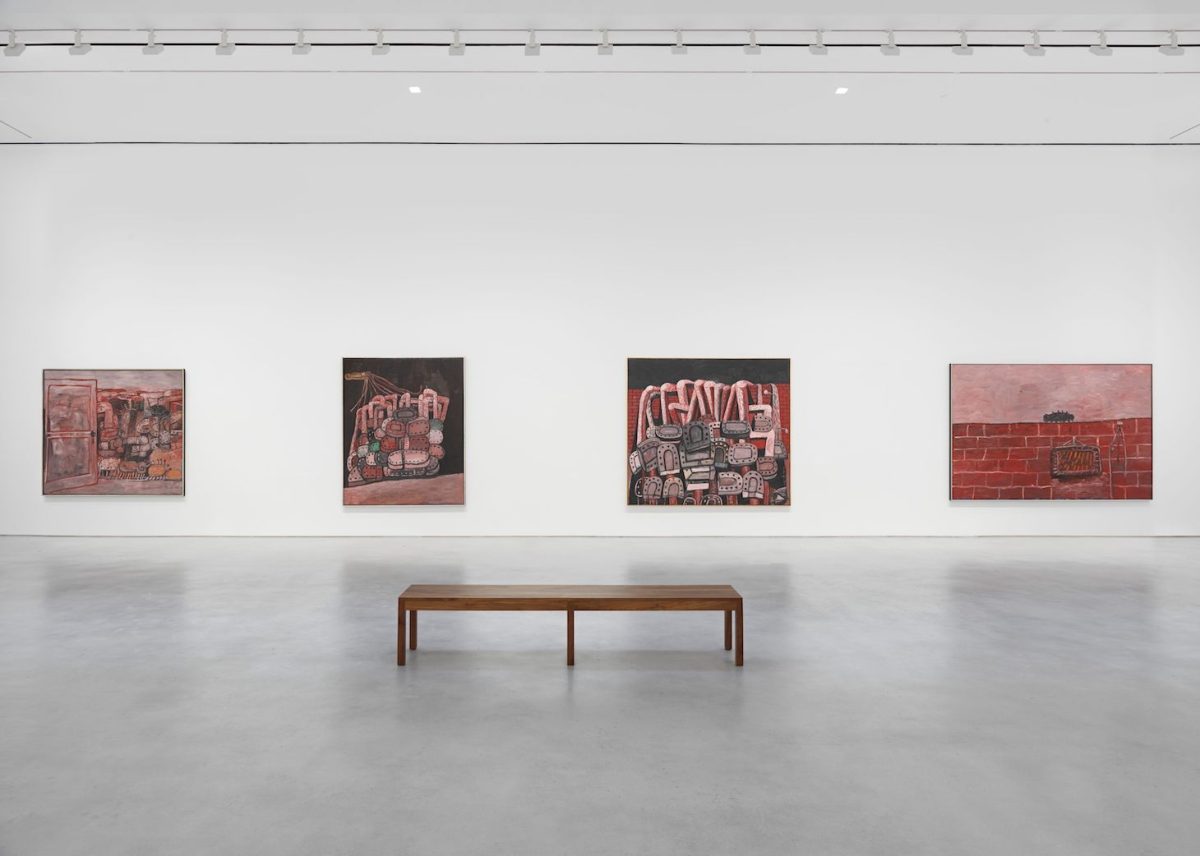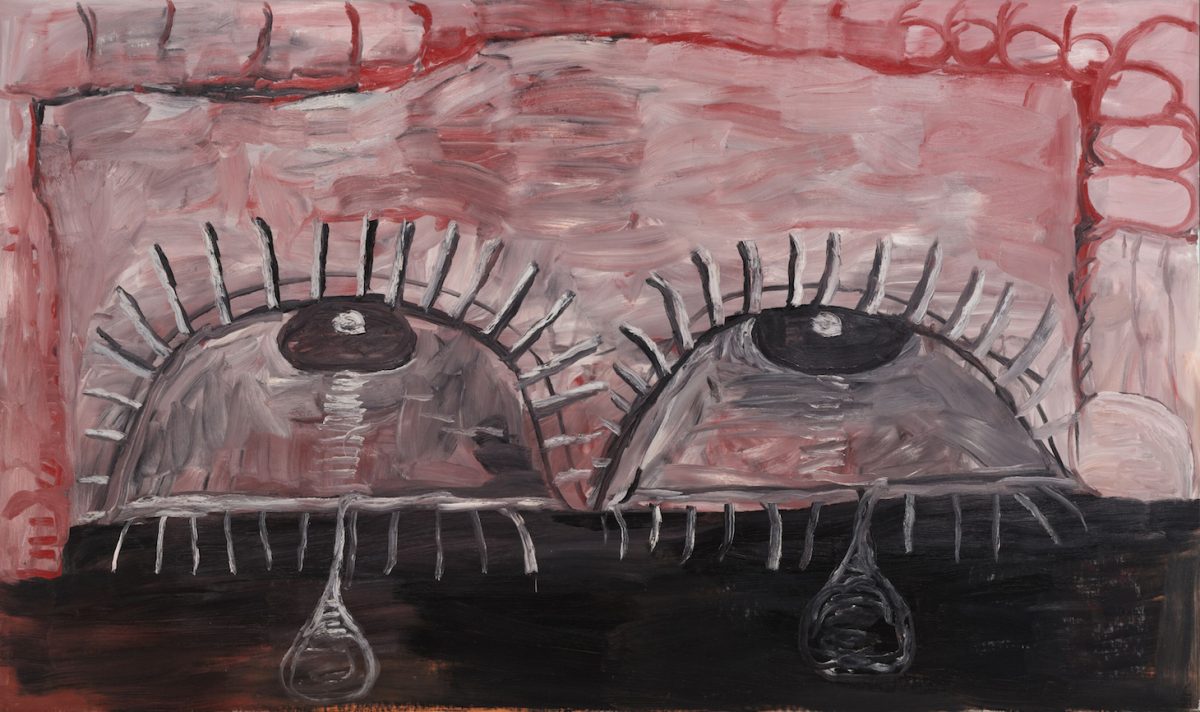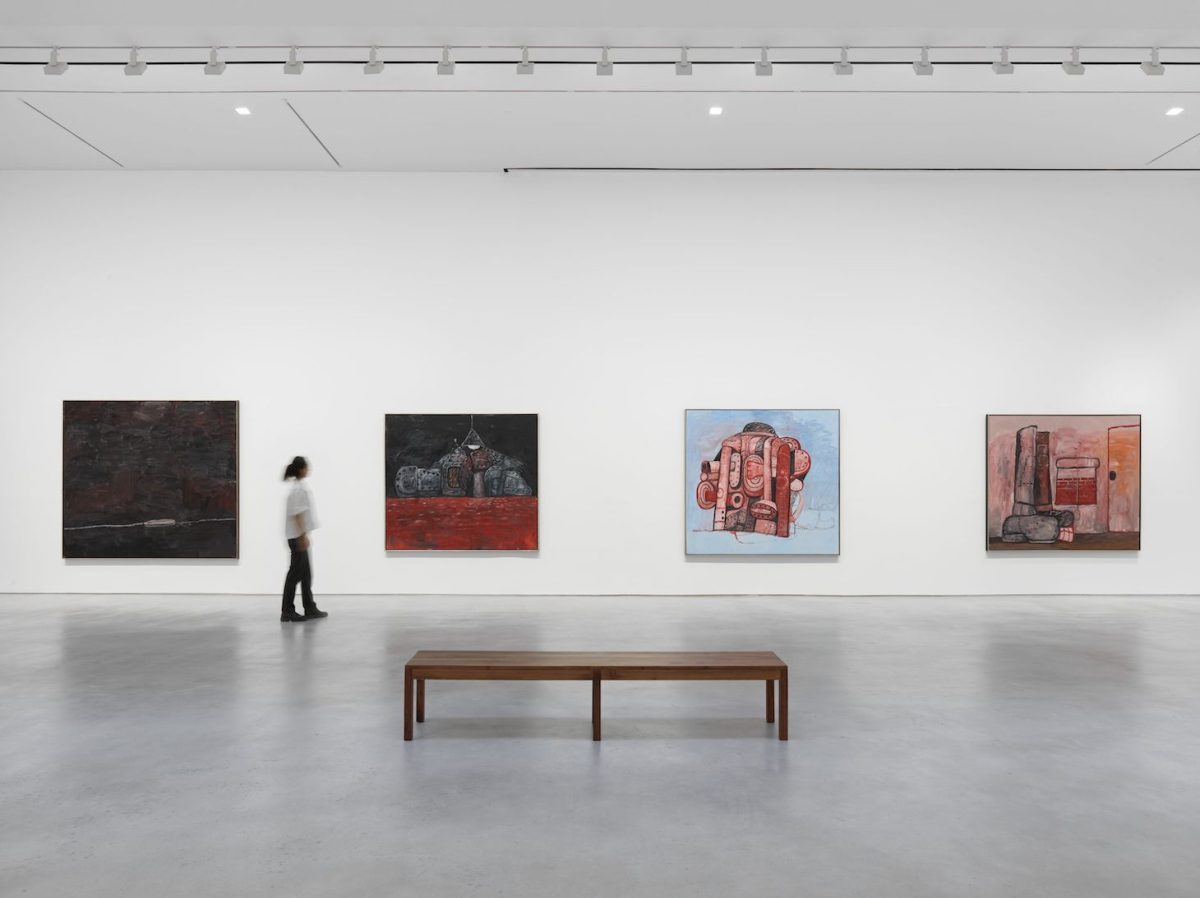
The exhibition Philip Guston: 1969–1979 at Hauser & Wirth (September 9–October 30, 2021) blows open a hole in nearly all the narratives of American art from that turbulent decade, though you would not know it if you read Art Since 1900 (2004), the standard art history textbook by Hal Foster, Rosalind Krauss, Yve-Alain Bois, and Benjamin H. D. Buchloh. In that book, Guston gets mentioned twice in passing. The authors have collectively ignored his groundbreaking 1970 show at Marlborough Gallery, where he exhibited his paintings of hooded figures for the first time. At the time of the show, the conservative critic Hilton Kramer ridiculed Guston with a review in The New York Times (October 25, 1970) titled “A Mandarin Pretending To Be a Stumblebum.” One of Guston’s closest friends, the composer Morton Feldman, stopped talking to him and they never reconciled.
And yet, even as Guston’s reception has changed over the years, beginning with the touring retrospective Philip Guston, which was thoughtfully organized by Henry T. Hopkins for the San Francisco Museum of Modern Art (1980-81), I wondered if we have not gotten stuck in some predictable responses to the paintings, especially those depicting the hooded figures (which he did only for a brief period).
Six paintings of the men in hoods are included in Philip Guston: 1969–1979. This is the wall text posted by the entrance to the first of two gallery spaces, in which they are exhibited:
Prompted by the violence and civil unrest in America in the 1960s, Guston explores motifs that harken back to his earliest figurative works of the 1930s. In his new world of clunky Ku Klux Klansmen, evil is disguised in the deceptive banality of everyday life. The hooded figures in the six works in this first room are engaged not in acts of terror but in everyday pursuits, smoking cigars, making plans, driving around in cars. Guston holds up a mirror not only to America’s racist past and present, but dares to examine his own complicity.

“Edge of Town” (1969), which is in the collection of the Museum of Modern Art, offers a different narrative. Guston painted over one of his earlier pink abstractions by demarcating a pale blue area. Against the sky, he has rendered a black rectangle with rounded edges, and the outline of the side view of a spare tire. This is a car that seems to have no wheels.
Two hooded figures sit in the roofless car smoking cigars. They face toward the part of the painting that Guston did not cover over. Behind them are boards, one of which has nails protruding from it. I see it as a stretcher bar from which a painting has been torn off. The hooded figures each have two vertical eye slits but nothing to suggest a mouth.
The MoMA website states of “Edge of Town”:
Hooded Klan figures first appeared in Guston’s works after one of his Los Angeles murals was vandalized by the Ku Klux Klan in 1933. Of these figures, Guston said, “They are self-portraits. I perceive myself as being behind the hood. … The idea of evil fascinated me … I almost tried to imagine that I was living with the Klan. What would it be like to be evil?”
More than 35 years later, when Guston returned to the motif of the hooded figures, he identified them as painters who cannot speak, having decided to join a club in which thinking and seeing for oneself is forbidden. Instead, they smoke cigars, remain mute, and sit in wheel-less vehicles that are not going anywhere.
When Guston revisited the motif, it was because he saw it as a symbol for the art world’s cliquishness and the pressure its various authorities and institutions applied to artists to subscribe to predetermined narratives regarding what was right and wrong to do in art. Those artists who elected to join the club willingly gave up their right to speak, but gained the privilege of smoking cigars. He recognizes that he has been one of them.

That club might have changed members and ideologies, but it has not gone away. This is one of the points I suggest we think about when looking at these paintings: the persistence of self-righteous individuals hiding behind ideologies both inside and outside the art world. In the painting “Blackboard” (1969), which I don’t believe has been previously exhibited, Guston has “drawn” three hooded figures on a blackboard mounted on a dirty pink wall, which is presumably in a classroom. In doing so he questions what gets taught, even in an art school.
In “Studio” (1969), Guston shows the hooded figure working on a self-portrait, and smoking a cigarette. By facing up to who he was — someone who had given too much credence to those who claimed you had to be an abstract artist whose practice was devoted to underscoring paint as paint — he knows he is on his way out of the club.
What is interesting about these paintings is that Guston never points at anyone else. In “Scared Stiff” (1970), a huge red hand from an unseen authority extends in from the painting’s right edge, pointing accusingly at a speechless, cigar-smoking hooded figure who is sweating blood. Guston know what his push for freedom will cost him and he doesn’t stop, though he is aware that others will feel betrayed, and become angry and unforgiving. What emerges is not a hero.
After his show at Marlborough Gallery, Guston spent a year at the American Academy in Rome (1970-71), a period this exhibition skips over. While there, he received a strongly positive review from Harold Rosenberg, which he did not expect, and he was inspired by sites of antiquity and by visiting Giorgio de Chirico, whose post-metaphysical paintings had been largely dismissed by American critics and museum curators. But Guston saw possibilities in de Chirico’s paintings of rooms with stretcher bars stacked together and boats floating on lakes, and transformed them into something that was unmistakably his own.

The paintings in the gallery’s second room were done between 1973 and ’79, the year before his death. I cannot think of another American artist who went as far as he did without a safety net. That is the example he offered younger artists — a chance to go “on nerve alone,” as his friend, the poet Frank O’Hara, wrote years earlier. It was in the company of younger poets who were mainly associated with the New York School that Guston found his greatest champions, who he provided with drawings for book covers and magazines, often printed inexpensively on mimeograph machines, and collaborated with, and whose poems he read and letters he answered. (I was in this latter group.)
In “Pittore” (1973) (translated as “Painter”), the earliest painting in this group, Guston depicts himself in profile lying in bed, a sheet pulled up to his neck; he is a lima bean-like head with a deeply creased forehead, one large eye open and staring at the ceiling, a cigarette sticking out of his mouth. A large clock is visible behind him, its bottom cropped by the sheet. It is going on 11:00 o’clock. Below the supine figure, Guston has written the painting’s title and depicted a paintbrush and four smears of color.
If this is a vision of a sleepless artist who does not know what he will do next, what follows is astonishing for the places he goes in his work. In “Painter’s Hand” (1975), we see a large hand holding a small canvas set on the edge of a table against a gray ground. An outlined orange sun is either rising or setting in the ocean, which is painted in streaks of red. Guston knows he cannot paint a generic subject as he moves forward.
Almost all the 10 paintings that comprise the rest of the exhibition are scenes set against a black background or an interior. These are haunted hypnagogic views that Guston explored rather than dismissed, no matter how unlikely and inexplicable they were. That is one reason why I think these works are great and powerful; he places the uncanny before us in creamy strokes of viscous paint. He makes his visions palpable. He knows his visions are inseparable from his body.

In “On Edge” (1978), which I have never seen before and which riveted me, Guston fills the large rectangular canvas with thick, viscous black paint covering over faint clouds of pink. A thin gray-pink line runs unevenly along the lower fifth of the painting, rising slightly as it crosses from the left to right edge. A little more than halfway across the line is a narrow, empty boat, neither a dory nor a canoe. This is a vision of bleakness that has no other context but the painting. It tells a story that has no beginning or ending, only its insistent and palpable present.
What are we to make of the two large semicircles in “Tears” (1977), which gaze upward as a large tear drips from each one? Why is the man in “Sleeping” (1977), who lies in bed, his head mostly hidden under a red blanket, wearing his shoes? What about the eye we see in the bottom right-hand corner of “Ancient Wall” (1976)?
How do we explain the long, skinny, hairy pink legs hanging over the red brick wall beneath a black sky? Why do some of the soles we see rising from the bottom of the black pit along the bottom of the painting resemble horseshoes? How do we explain the cadaverous gray leg directly above the eye? Why has it been nailed to the wall? What makes these questions powerful and urgent is that they feel like they are coming from the depths of Guston’s being. Aware that time is catching up with him, he paints without trying to rationalize or explain these visions. In the 1950s, when he was producing the pink paintings made of vertical and horizontal strokes dispersed across the center but never reaching the edge, Guston never stepped back to see the work in its entirety. He concentrated only on what was in front of him. This is what he did in the late pieces as well: working wet into wet, he let himself be carried along by the painting and he never blinked.
Philip Guston: 1969–1979 continues at Hauser & Wirth (542 West 22nd Street, Chelsea, Manhattan) through October 30.
0 Commentaires